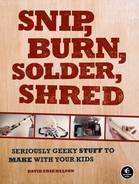There’s lots of room to customize and modify the $10 Electric Guitar. You can start by tuning to a different note; the markings will still be workable guides for the scales. You can also try different gauge strings; although the thinner, unwound guitar strings tend to sound flat (because there are no metal frets on the diddley bow’s neck, it’s hard to get a clear note fretting these thinner strings), the thicker wound guitar strings (the D, A, and low E string) all sound good.
The cookie tin functions as a very quiet resonator, giving the diddley bow enough volume so you can tune it and play it without an amp handy. The tin also makes it easier to rest the instrument on your lap while playing, and it gives the wires somewhere to go. You could omit the resonator altogether or replace it with a flat piece of wood, and this electric diddley bow would sound almost exactly the same. Conversely, if you want an all-acoustic diddley bow, try using a larger resonator (such as a large cigar box or a 5″ deep piece from the bottom of a 5-gallon plastic bucket).
The pickup, bridge, and tuning peg are mounted so that you can easily add a second, lower-pitched string to the top of the neck (i.e., the side where your thumb rests when you’re playing), a mirror image of the first string (Figure 13-21).[8] Use the next thicker string from the guitar (in this case you’d want the D string), and experiment with different tuning combinations. A good place to start is tuning the thinner string up to the G below middle C (the same as the G string on a guitar in standard tuning) and the thicker string to the G one octave lower. In this configuration, you can either fret both strings together to get a thicker sound for each note or leave the lower G string open as you strum so that it will function as a drone.
A slightly advanced technique is to have the two strings a fourth apart (i.e., if you’re going by the book, the lower-pitched string is tuned to D and the higher to G; see Table 13-2 for other combos of fourths).
Table 13-2. Fourths
If the higher-pitched string is . . . | Then tune the lower-pitched string to . . . |
|---|---|
G | D |
A | E |
B | F♯ |
C | G |
D | A |
E | B |
F | C |
With the strings tuned a fourth apart in this manner, you can play an inverted power chord (i.e., one where the higher, rather than lower, note is the root) by just laying your finger across the strings (i.e., barring them, shown in Figure 13-22). In other words, on my diddley bow (which uses a G string for the higher-pitched string and a D for the optional, second, lower string), strumming the open strings plays a G power chord, placing my finger across both at the second dot plays a C power chord, barring at the fifth dot plays a D power chord, and barring at the last dot plays a G power chord one octave higher than the first. This is similar to playing in drop D tuning on a regular guitar; Kurt Cobain fans might think of this two-string electric diddley bow as a the Nirvanatar.
Finally, since the $10 Electric Guitar is fretless, there is a tremendous temptation to play a single-string model with a bow, like a junkyard cello. You can make a great, never-need-to-rosin fiddlestick from a piece of bicycle tire inner tube stretched over some scrap wood (see Figure 13-23). Most bike shops have scads of leaky tire inner tubes lying around and are more than happy to give them away rather than send them to a landfill.
[8] In fact, the neck is wide enough that a clever and nimble-fingered crafter could likely bring this design up to full six-string functionality, provided he or she notched the saddle and nut in order to keep the highest and lowest strings in place or replaced the nut and saddle with comparably sized coarse-threaded bolts.



